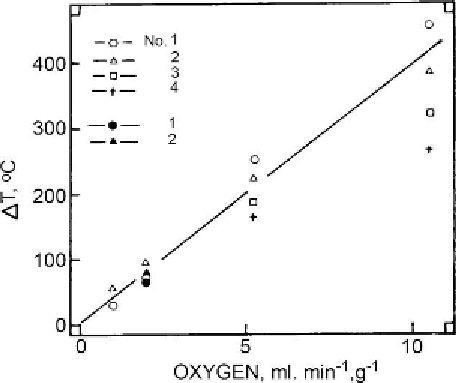Environmental Engineering Reference
In-Depth Information
Figure 6.26: Effect of O
2
concentration in regeneration gas on temperature runway in four zones
of fixed bed (solid symbols for tetrahydrofuran [THF] extracted catalyst) [From refs
419
and
420
. Reprinted with permission].
of spent catalyst was 350
◦
C. From this correlation, it can be estimated that the O
2
concentration of about 4 vol.% can ensure the temperature excursion to less than 500
◦
C. Thus,
according to
Figs 6.17 and 6.22 [401,367,368]
, in order to achieve a high recovery of catalyst
activity, the temperature of regeneration should not exceed 500
◦
C.
The correlation in
Fig. 6.26 [420]
is applicable to a specific spent catalyst, i.e., it cannot be
applied generally. This is confirmed by the results in
Fig. 6.25 [419]
. The temperature profiles
in
Figs 6.25 and 6.27
were obtained for catalyst A and catalyst B, respectively. The properties
of these catalysts are given in
Table 6.9
. The temperature excursion in air for the much more
coke deposited catalyst B was lower compared with that for catalyst A. This can be attributed
to a much smaller surface area of catalyst B, which allowed only an external chemically
Table 6.9: Composition of coke (wt.%) on spent catalysts [From ref.
419
. Reprinted with
permission].
Catalyst A
Catalyst B
Carbon
7
.
2
26
.
2
Hydrogen
0
.
8
3
.
5
H/C
1
.
3
1
.
6
Nitrogen
0
.
40
0
.
27
Sulfur
7
.
13
5
.
48

















